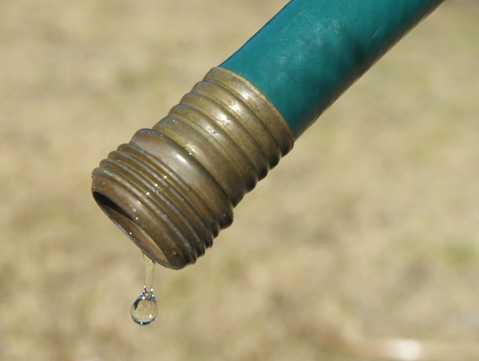City Declares Stage II Drought
Mandatory Water Restrictions, Higher Rates, New Supplies on the Way

While the Santa Barbara City Council did not officially decree that the only good lawn is a dead one, it took a definite step in that direction this Tuesday, declaring a Stage II drought emergency. In fact, acting city water czar Josh Haggmark declared, “Short term, the best thing is to let lawns die. Let them go.”
Under the new Stage II rules, fines as high as $250 per offense can now be imposed on residents who water their lawns during daylight hours, hose down their sidewalks, or use a hose without a flow-control nozzle. In addition, the council embraced a new rate structure designed to punish water customers who use more than what’s required for basic bathing, flushing, and drinking. The new restrictions were imposed only after previous efforts to elicit voluntary reductions of 20 percent did not pan out. As a result, low water users will see a slight bump of 81 cents in their water bills. Moderate users will experience a $10 monthly increase, and heavy users will be charged $130 more a month.
If these measures don’t achieve their desired effect, Councilmember Frank Hotchkiss wondered, what is Haggmark’s Plan B? “Flush your toilet once a week?” he asked. Councilmember Bendy White expressed concern the higher rates were “a little gentle,” but he said they could always be raised later if need be. Based on his experience in the last drought, he said, new rules can generate enforcement nightmares. “The regulatory side of this is a bummer,” he opined, “and it doesn’t generate the same spirit.”
The council’s action took place just one week after Santa Barbara County withered under a record-setting heat wave. During its peak, Lake Cachuma — the South Coast’s major water supply — lost 54 acre-feet of water a day. Typically at this time of year, evaporation claims only half that. Governor Jerry Brown blamed climate change, noting how the drought has sparked an unprecedented eruption of wildfires. In the first five months of 2014, he said, California has experienced 1,800. Normally, there are 800 in an entire year.
The severity of the drought — caused by three of the consecutive driest years on record — helped persuade even the most reluctant of water districts making up the Cachuma Operation and Maintenance Board (COMB) to agree to a 55 percent reduction in water deliveries effective October 1. As a result, the districts will have to make do with deliveries of about 11,500 acre-feet of water next year instead of 25,700. There wasn’t a whole lot of choice, said Tom Fayram, head of the county Flood Control District and Water Agency. “We could use it all up this year and pray to God it rains,” he said. “Or we could cut back use so that hopefully we might have a little left by 2016.”
COMB member agencies also just signed a contract to spend up to $6 million to pay a private contractor to design and build a new pump station and barge if and when Lake Cachuma drops so low that water has to be pumped up to get into the delivery tunnels. That’s nearly 10 times more than the district spent during the drought 19 years ago to accomplish the same objective. But COMB director Randy Ward said the project envisioned today is much different than its predecessor. He noted the cost of installing new electrical wires to power the barged pump is nearly $750,000 and that the price of electricity alone could be $40,000 a month. If all goes as planned, Ward said the new pumping facility should be ready by September 19.
The good news is the Central Coast Water Authority (CCWA) — the super agency responsible for the importation of state water to Santa Barbara County — has secured an additional 5,883 acre-feet of supplies. In addition, the February and March rains provided enough relief so that at least some deliveries — 5 percent of entitlements — can be made this year. Initially, the state water system was so stressed that its managers determined they could make zero deliveries, a first in the project’s history. “I’m not inclined to say ‘Hoo-hah! The pressure’s off,’” said CCWA chief Ray Stokes. “The situation’s still dire, but it’s eased up a bit.”



